Introduction to Machine Learning
67577 - Fall, 2008
Amnon Shashua
School of Computer Science and Engineering
The Hebrew University of Jerusalem
Jerusalem, Israel
9
0
0
2
r
p
A
3
2
]
G
L
.
s
c
[
1
v
4
6
6
3
.
4
0
9
0
:
v
i
X
r
a
�
�
1
3
4
Contents
iii
2 Maximum Likelihood/ Maximum Entropy Duality
Bayesian Decision Theory
1.1
Independence Constraints
1.1.1 Example: Coin Toss
1.1.2 Example: Gaussian Density Estimation
Incremental Bayes Classifier
1.2
1.3 Bayes Classifier for 2-class Normal Distributions
2.1 ML and Empirical Distribution
2.2 Relative Entropy
2.3 Maximum Entropy and Duality ML/MaxEnt
EM Algorithm: ML over Mixture of Distributions
3.1 The EM Algorithm: General
3.2 EM with i.i.d. Data
3.3 Back to the Coins Example
3.4 Gaussian Mixture
3.5 Application Examples
page 1
5
7
7
9
10
12
12
14
15
19
21
24
24
26
27
3.5.1 Gaussian Mixture and Clustering
27
3.5.2 Multinomial Mixture and ”bag of words” Application 27
30
Large Margin Classifier as a Quadratic Linear Programming 31
34
36
37
38
39
39
Support Vector Machines and Kernel Functions
4.1
4.2 The Support Vector Machine
4.3 The Kernel Trick
4.3.1 The Homogeneous Polynomial Kernel
4.3.2 The non-homogeneous Polynomial Kernel
4.3.3 The RBF Kernel
4.3.4 Classifying New Instances
�
iv
5
6
7
8
9
Contents
Spectral Analysis I: PCA, LDA, CCA
5.1 PCA: Statistical Perspective
5.1.1 Maximizing the Variance of Output Coordinates
5.1.2 Decorrelation: Diagonalization of the Covariance
Matrix
5.2 PCA: Optimal Reconstruction
5.3 The Case n >> m
5.4 Kernel PCA
5.5 Fisher’s LDA: Basic Idea
5.6 Fisher’s LDA: General Derivation
5.7 Fisher’s LDA: 2-class
5.8
5.9 Canonical Correlation Analysis
Spectral Analysis II: Clustering
6.1 K-means Algorithm for Clustering
LDA versus SVM
6.1.1 Matrix Formulation of K-means
6.2 Min-Cut
6.3
Spectral Clustering: Ratio-Cuts and Normalized-Cuts
6.3.1 Ratio-Cuts
6.3.2 Normalized-Cuts
The Formal (PAC) Learning Model
7.1 The Formal Model
7.2 The Rectangle Learning Problem
7.3
Learnability of Finite Concept Classes
7.3.1 The Realizable Case
7.3.2 The Unrealizable Case
The VC Dimension
8.1 The VC Dimension
8.2 The Relation between VC dimension and PAC Learning
The Double-Sampling Theorem
9.1 A Polynomial Bound on the Sample Size m for PAC
Learning
9.2 Optimality of SVM Revisited
10 Appendix
Bibliography
41
42
43
46
47
49
49
50
52
54
54
55
58
59
60
62
63
64
65
69
69
73
75
76
77
80
81
85
89
89
95
97
105
�
1
Bayesian Decision Theory
During the next few lectures we will be looking at the inference from training
data problem as a random process modeled by the joint probability distribu-
tion over input (measurements) and output (say class labels) variables. In
general, estimating the underlying distribution is a daunting and unwieldy
task, but there are a number of constraints or ”tricks of the trade” so to
speak that under certain conditions make this task manageable and fairly
effective.
To make things simple, we will assume a discrete world, i.e., that the
values of our random variables take on a finite number of values. Consider
for example two random variables X taking on k possible values x1, ..., xk
and H taking on two values h1, h2. The values of X could stand for a Body
Mass Index (BMI) measurement weight/height2 of a person and H stands
for the two possibilities h1 standing for the ”person being over-weight” and
h2 as the possibility ”person of normal weight”. Given a BMI measurement
we would like to estimate the probability of the person being over-weight.
The joint probability P (X, H) is a two dimensional array (2-way array)
with 2k entries (cells). Each training example (xi, hj) falls into one of those
cells, therefore P (X = xi, H = hj) = P (xi, hj) holds the ratio between the
number of hits into cell (i, j) and the total number of training examples
(assuming the training data arrive i.i.d.). As a result
P (hj) =
measurement — these are called priors. Likewise, P (xi) =
The projections of the array onto its vertical and horizontal axes by sum-
ming over columns or over rows is called marginalization and produces
i P (xi, hj) the sum over the j’th row is the probability P (H = hj),
i.e., the probability of a person being over-weight (or not) before we see any
j P (xi, hj)
is the probability P (X = xi) which is the probability of receiving such
a BMI measurement to begin with — this is often called evidence. Note
ij P (xi, hj) = 1.
1
�
2
Bayesian Decision Theory
h1
h2
2
0
5
0
4
3
2
3
1
2
x1
x2
x3
x4
x5
Fig. 1.1. Joint probability P (X, H) where X ranges over 5 discrete values and H
over two values. Each entry contains the number of hits for the cell (xi, hj). The
joint probability P (xi, hj) is the number of hits divided by the total number of hits
(22). See text for more details.
that, by definition,
j P (hj) =
i P (xi) = 1.
In Fig. 1.1 we have that
P (h1) = 14/22, P (h2) = 8/22 that is there is a higher prior probability of a
person being over-weight than being of normal weight. Also P (x3) = 7/22
is the highest meaning that we encounter BMI = x3 with the highest prob-
ability.
The conditional probability P (hj | xi) = P (xi, hj)/P (xi) is the ratio be-
tween the number of hits in cell (i, j) and the number of hits in the i’th
column, i.e., the probability that the outcome is H = hj given the measure-
ment X = xi. In Fig. 1.1 we have P (h2 | x3) = 3/7. Note that
P (hj | xi) =
j
j
P (xi, hj)
P (xi)
=
1
P (xi)
j
P (xi, hj) = P (xi)/P (xi) = 1.
Likewise, the conditional probability P (xi | hj) = P (xi, hj)/P (hj) is the
number of hits in cell (i, j) normalized by the number of hits in the j’th row
and represents the probability of receiving BMI = xi given the class label
H = hj (over-weight or not) of the person. In Fig. 1.1 we have P (x3 | h2) =
3/8 which is the probability of receiving BMI = x3 given that the person is
known to be of normal weight. Note that
i P (xi | hj) = 1.
The Bayes formula arises from:
P (xi | hj)P (hj) = P (xi, hj) = P (hj | xi)P (xi),
from which we get:
P (hj | xi) = P (xi | hj)P (hj)
.
P (xi)
The left hand side P (hj | xi) is called the posterior probability and P (xi | hj)
is called the class conditional likelihood. The Bayes formula provides a
way to estimate the posterior probability from the prior, evidence and class
likelihood. It is useful in cases where it is natural to compute (or collect
data of) the class likelihood, yet it is not quite simple to compute directly
�
Bayesian Decision Theory
3
the posterior. For example, given a measurement ”12” we would like to
estimate the probability that the measurement came from tossing a pair
of dice or from spinning a roulette table. If x = 12 is our measurement,
and h1 stands for ”pair of dice” and h2 for ”roulette” then it is natural
to compute the class conditional: P (”12” | ”pair of dice”) = 1/36 and
P (”12” | ”roulette”) = 1/38. Computing the posterior directly is much
more difficult. As another example, consider medical diagnosis. Once it is
known that a patient suffers from some disease hj, it is natural to evaluate
the probabilities P (xi | hj) of the emerging symptoms xi. As a result, in
many inference problems it is natural to use the class conditionals as the
basic building blocks and use the Bayes formula to invert those to obtain
the posteriors.
The Bayes rule can often lead to unintuitive results — the one in particu-
lar is known as ”base rate fallacy” which shows how an nonuniform prior can
influence the mapping from likelihoods to posteriors. On an intuitive basis,
people tend to ignore priors and equate likelihoods to posteriors. The follow-
ing example is typical: consider the ”Cancer test kit” problem† which has the
following features: given that the subject has Cancer ”C”, the probability
of the test kit producing a positive decision ”+” is P (+ | C) = 0.98 (which
means that P (− | C) = 0.02) and the probability of the kit producing a neg-
ative decision ”-” given that the subject is healthy ”H” is P (− | H) = 0.97
(which means also that P (+ | H) = 0.03). The prior probability of Cancer
in the population is P (C) = 0.01. These numbers appear at first glance
as quite reasonable, i.e, there is a probability of 98% that the test kit will
produce the correct indication given that the subject has Cancer. What
we are actually interested in is the probability that the subject has Cancer
given that the test kit generated a positive decision, i.e., P (C | +). Using
Bayes rule:
P (C | +) = P (+ | C)P (C)
P (+ | C)P (C)
= 0.266
P (+)
=
P (+ | C)P (C) + P (+ | H)P (H)
which means that there is a 26.6% chance that the subject has Cancer given
that the test kit produced a positive response — by all means a very poor
performance.
If we draw the posteriors P (h1 |x) and P (h2 | x) using the probability
distribution array in Fig. 1.1 we will see that P (h1 |x) > P (h2 | x) for all
values of X smaller than a value which is in between x3 and x4. Therefore
the decision which will minimize the probability of misclassification would
† This example is adopted from Yishai Mansour’s class notes on Machine Learning.
�
4
Bayesian Decision Theory
be to choose the class with the maximal posterior:
P (hj | x),
h∗ = argmax
j
which is known as the Maximal A Posteriori (MAP) decision principle. Since
P (x) is simply a normalization factor, the MAP principle is equivalent to:
h∗ = argmax
j
P (x | hj)P (hj).
In the case where information about the prior P (h) is not known or it is
known that the prior is uniform, the we obtain the Maximum Likelihood
(ML) principle:
h∗ = argmax
j
P (x | hj).
The MAP principle is a particular case of a more general principle, known
as ”proper Bayes”, where a loss is incorporated into the decision process.
Let l(hi, hj) be the loss incurred by deciding on class hi when in fact hj is
the correct class. For example, the ”0/1” loss function is:
1 i = j
0 i = j
l(hi, hj) =
The least-squares loss function is: l(hi, hj) = hi − hj2 typically used when
the outcomes are vectors in some high dimensional space rather than class
labels. We define the expected risk:
R(hi | x) =
l(hi, hj)P (hj | x).
The proper Bayes decision policy is to minimize the expected risk:
j
h∗ = argmin
j
R(hj | x).
The MAP policy arises in the case l(hi, hj) is the 0/1 loss function:
R(hi | x) =
j=i
P (hj | x) = 1 − P (hi | x),
Thus,
argmin
j
R(hj | x) = argmax
j
P (hj | x).
�
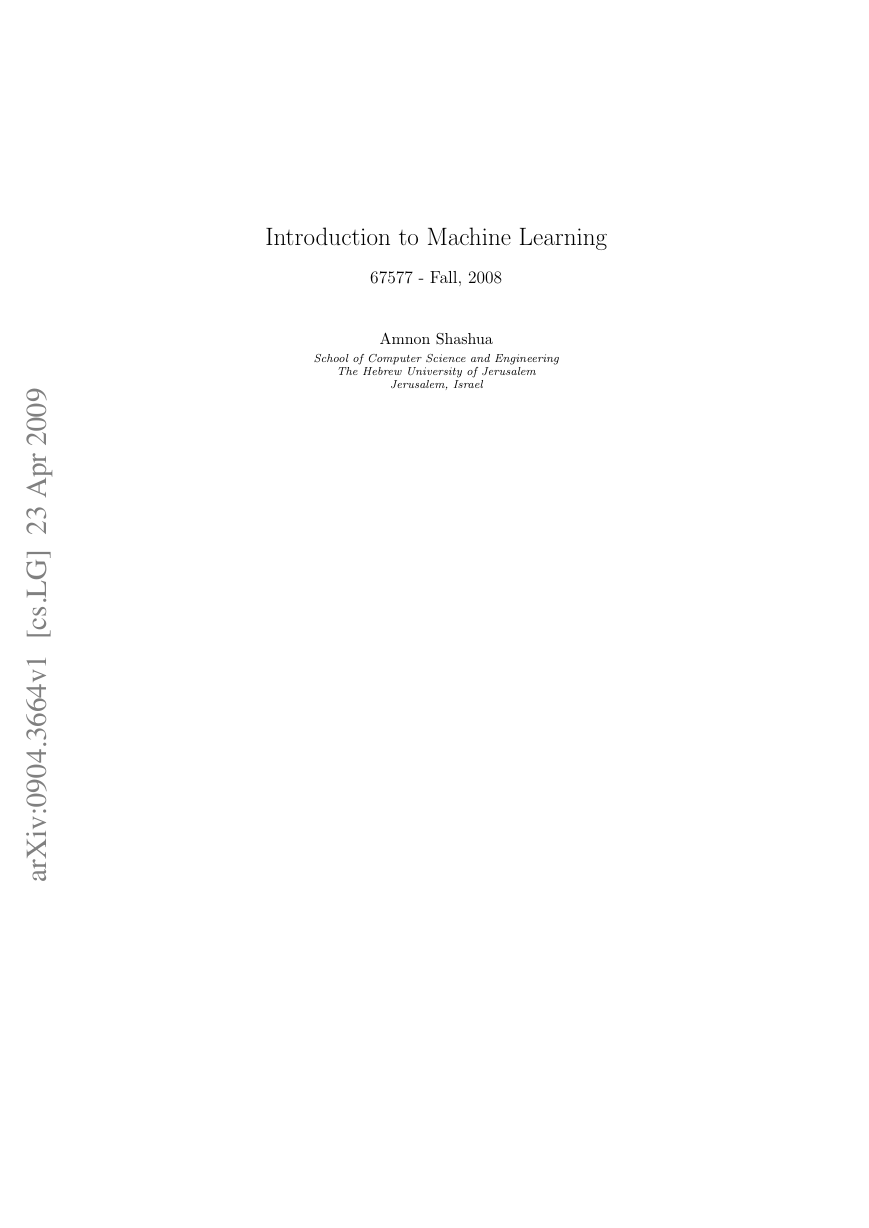

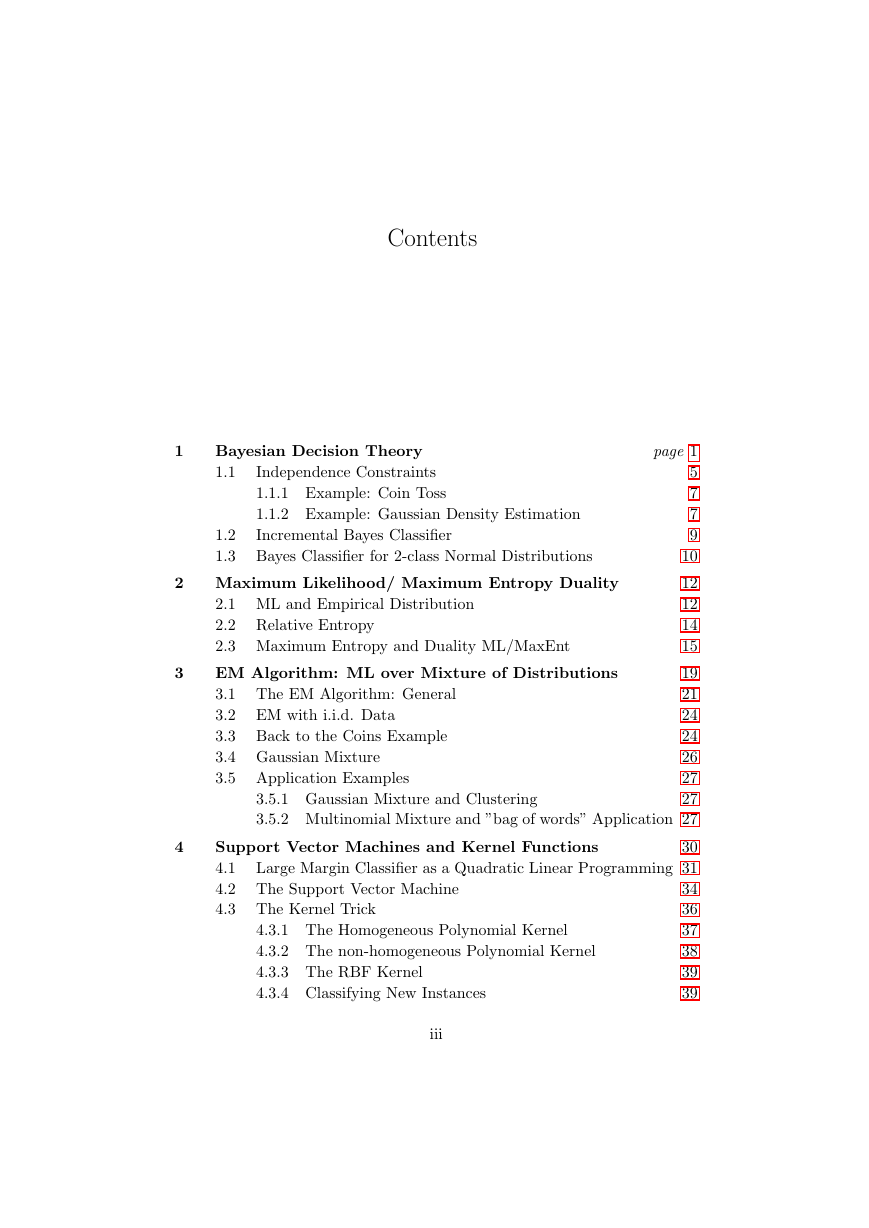

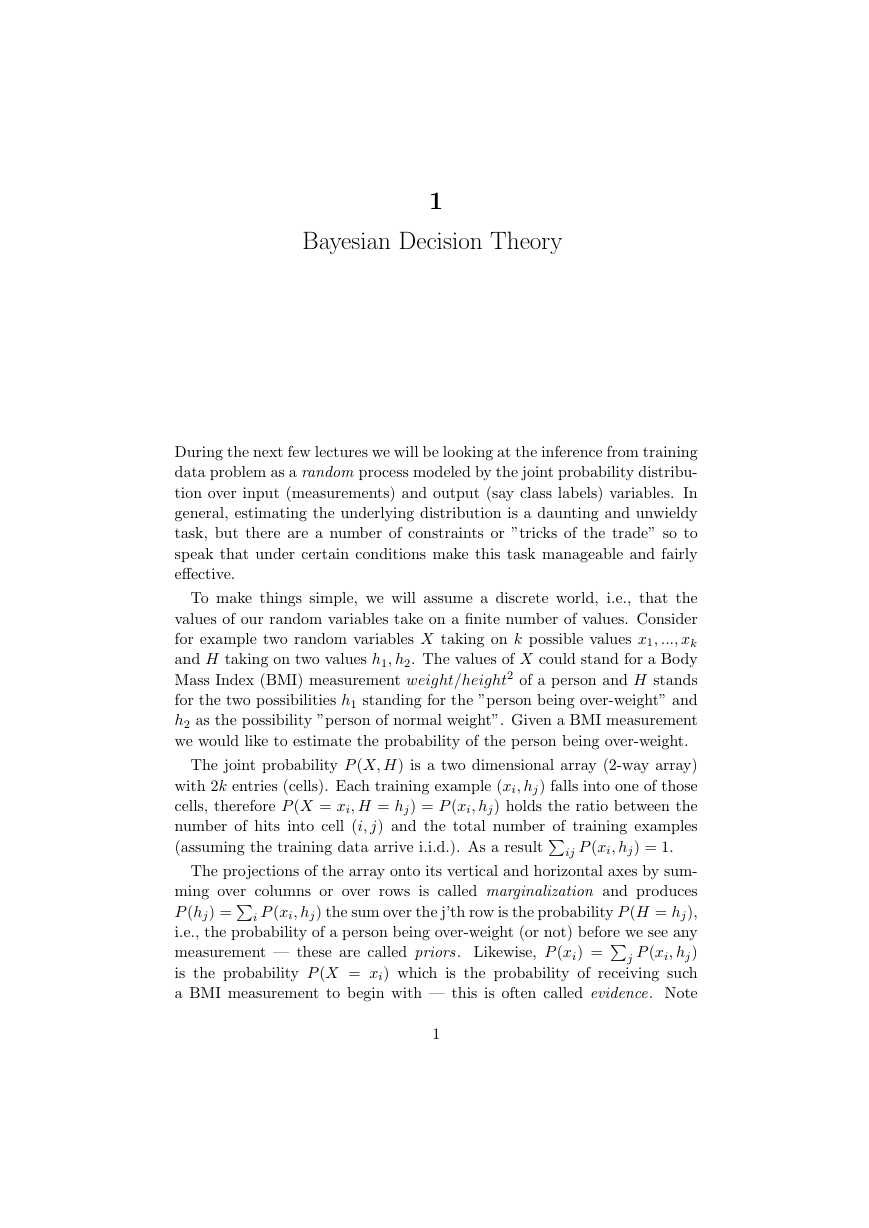
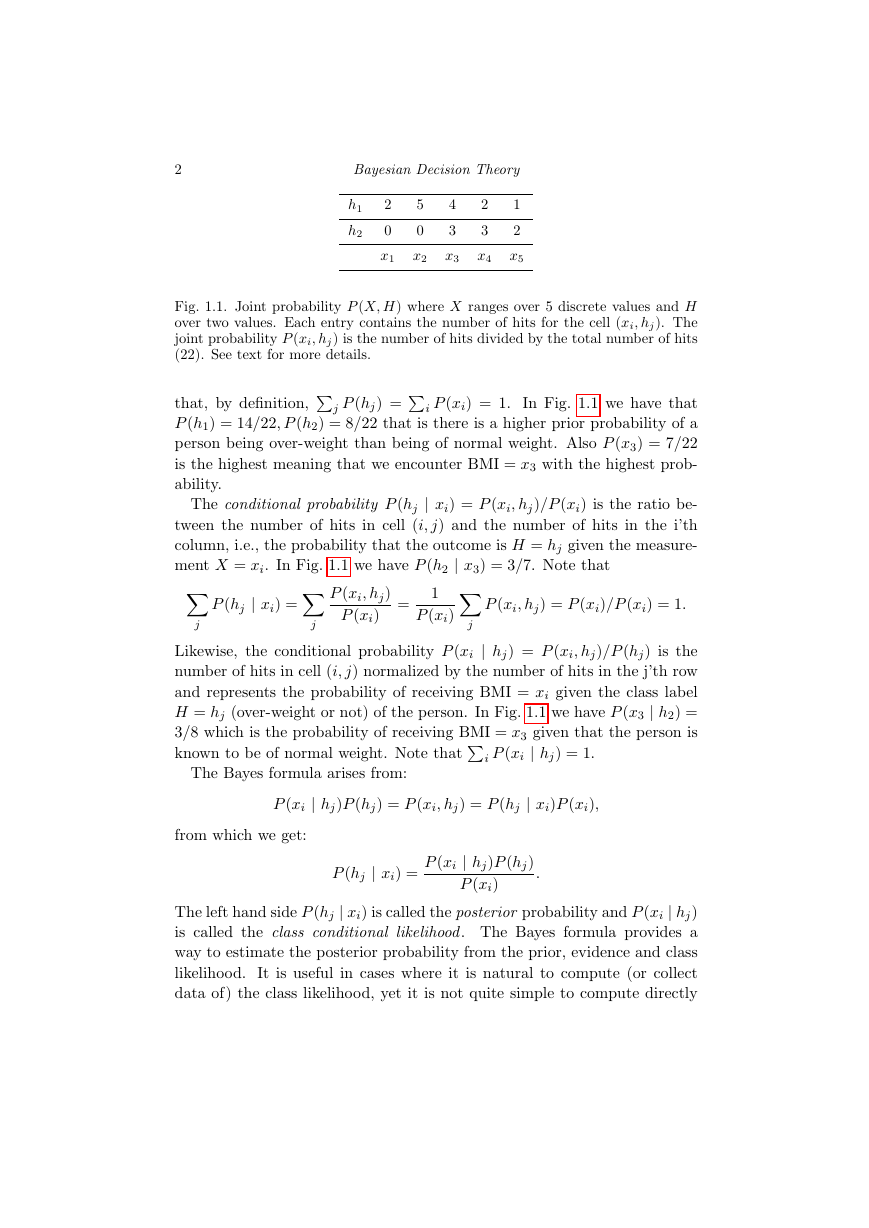

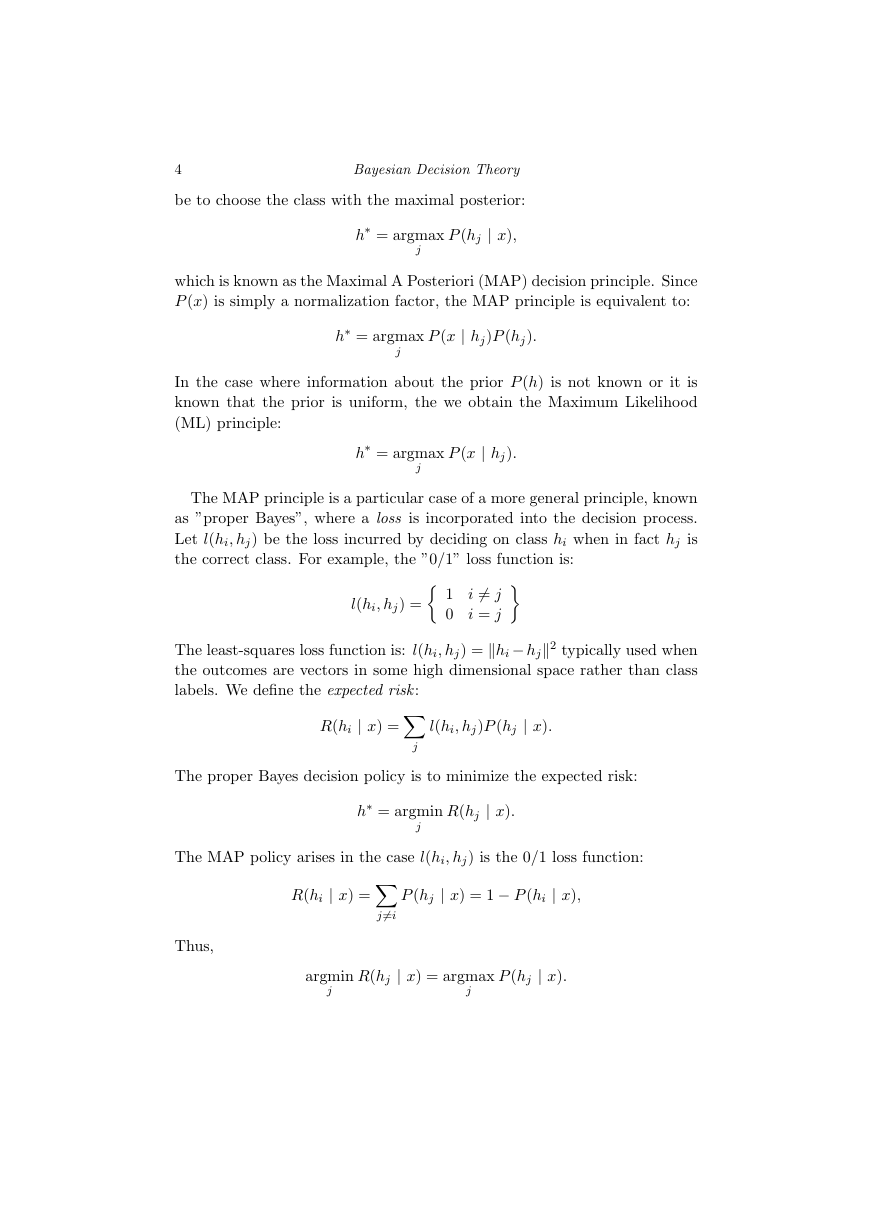








 2023年江西萍乡中考道德与法治真题及答案.doc
2023年江西萍乡中考道德与法治真题及答案.doc 2012年重庆南川中考生物真题及答案.doc
2012年重庆南川中考生物真题及答案.doc 2013年江西师范大学地理学综合及文艺理论基础考研真题.doc
2013年江西师范大学地理学综合及文艺理论基础考研真题.doc 2020年四川甘孜小升初语文真题及答案I卷.doc
2020年四川甘孜小升初语文真题及答案I卷.doc 2020年注册岩土工程师专业基础考试真题及答案.doc
2020年注册岩土工程师专业基础考试真题及答案.doc 2023-2024学年福建省厦门市九年级上学期数学月考试题及答案.doc
2023-2024学年福建省厦门市九年级上学期数学月考试题及答案.doc 2021-2022学年辽宁省沈阳市大东区九年级上学期语文期末试题及答案.doc
2021-2022学年辽宁省沈阳市大东区九年级上学期语文期末试题及答案.doc 2022-2023学年北京东城区初三第一学期物理期末试卷及答案.doc
2022-2023学年北京东城区初三第一学期物理期末试卷及答案.doc 2018上半年江西教师资格初中地理学科知识与教学能力真题及答案.doc
2018上半年江西教师资格初中地理学科知识与教学能力真题及答案.doc 2012年河北国家公务员申论考试真题及答案-省级.doc
2012年河北国家公务员申论考试真题及答案-省级.doc 2020-2021学年江苏省扬州市江都区邵樊片九年级上学期数学第一次质量检测试题及答案.doc
2020-2021学年江苏省扬州市江都区邵樊片九年级上学期数学第一次质量检测试题及答案.doc 2022下半年黑龙江教师资格证中学综合素质真题及答案.doc
2022下半年黑龙江教师资格证中学综合素质真题及答案.doc